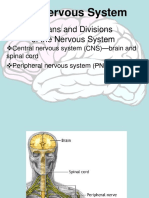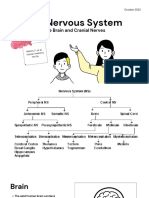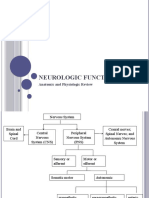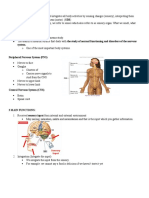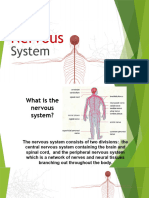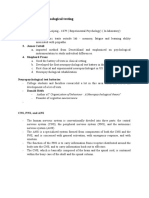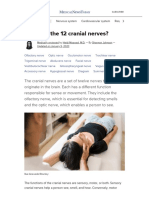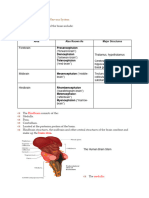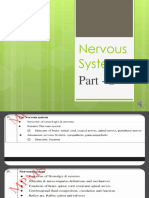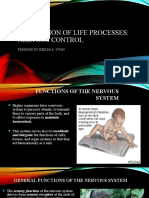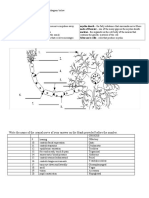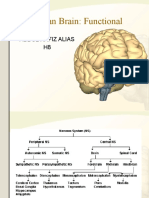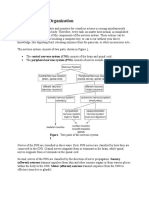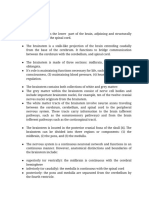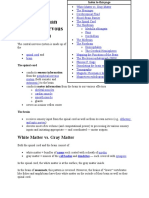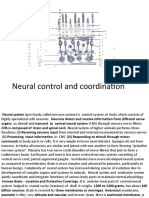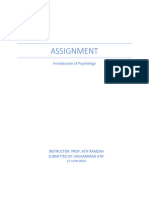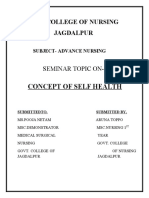Handout Brain & Cranial Nerves: M.SC NSG Ist Year
Handout Brain & Cranial Nerves: M.SC NSG Ist Year
Uploaded by
aparnaCopyright:
Available Formats
Handout Brain & Cranial Nerves: M.SC NSG Ist Year
Handout Brain & Cranial Nerves: M.SC NSG Ist Year
Uploaded by
aparnaOriginal Title
Copyright
Available Formats
Share this document
Did you find this document useful?
Is this content inappropriate?
Copyright:
Available Formats
Handout Brain & Cranial Nerves: M.SC NSG Ist Year
Handout Brain & Cranial Nerves: M.SC NSG Ist Year
Uploaded by
aparnaCopyright:
Available Formats
M.
Sc Nsg Ist year
HANDOUT
BRAIN & CRANIAL NERVES
INTRODUCTION :- The nervous system is our body's decision and communication center.
The central nervous system (CNS) is made of the brain and the spinal cord and the peripheral
nervous system (PNS) is made of nerves. The brain and spinal cord are the two main
structures of the central nervous system.
DEFINITION:- Brain is an organ made up of soft nervous tissue which is present inside the
cranium, function as the coordinating centre of sensation & intellectual and nervous activity.
STRUCTURE OF BRAIN
The brain is made of three main parts:
Forebrain.(Prosencephalon)
Diencephalon
Cerebrum
Midbrain.(Mesencephalon)
Tectum
Tegmentum
Hindbrain.(Rhombencephalon)
Cerebellum
Pons
Medulla oblongata
CRANIAL NERVES
There are 12 pairs of cranial nerves originating from the nuclei in the inferior surface of the
brain, some sensory ,some motor and some mixed.
I. Olfactory Nerve: Responsible for sense of smell
II. Optic Nerve: Plays a role in vision
III. Oculomotor Nerve: Controls movement of the eyeballs and eyelids
IV. Trochlear Nerve: Also involved in movement of the eye
V. Trigeminal Nerve: Performs a wide variety of functions, including chewing and
facial sensation.
VI. Abducent Nerve: Involved in eye movement
VII. Facial Nerve: Controls taste and facial expressions
VIII. Vestibulocochlear Nerve: Responsible for hearing and balance
IX. Glossopharyngeal Nerve: Responsible for controlling saliva, taste, and swallowing
X. Vagus Nerve: Plays a role in the motion of the lungs, throat, heart and digestive
system
XI. Accessory Nerve: Moves the shoulders and neck
XII. Hypoglossal Nerve: Controls speech, tongue, and swallowing
You might also like
- Group DynamicDocument11 pagesGroup Dynamicaparna100% (2)
- Subinvolution of UterusDocument18 pagesSubinvolution of Uterusaparna100% (2)
- Presentasi Penjelasan 1Document17 pagesPresentasi Penjelasan 1sri wulan100% (1)
- Nervous SystemDocument4 pagesNervous SystemShaira CogollodoNo ratings yet
- Assigment About NeurologyDocument5 pagesAssigment About NeurologyYola NoviyanaNo ratings yet
- AD 7 The Nervous SystemDocument28 pagesAD 7 The Nervous SystemBernard SalimNo ratings yet
- Neurologic Function: Anatomic and Physiologic ReviewDocument28 pagesNeurologic Function: Anatomic and Physiologic ReviewJeanette SampangNo ratings yet
- Anatomy and Physiology - The Nervous SystemDocument16 pagesAnatomy and Physiology - The Nervous Systemxuxi dulNo ratings yet
- Bme 514Document38 pagesBme 514Emmanuel NwankwoNo ratings yet
- Assessment of Neurologic FunctionsDocument45 pagesAssessment of Neurologic Functions27b7976xtjNo ratings yet
- The Human Brain: Anatomy, FunctionsDocument47 pagesThe Human Brain: Anatomy, FunctionsdeanadiahNo ratings yet
- Anaphy Lab Disc 7Document44 pagesAnaphy Lab Disc 7BSLMS1D - Depasupil, Laurice Ann A.No ratings yet
- CNP Module 2 - Brain and Spinal CordDocument13 pagesCNP Module 2 - Brain and Spinal CordTerrin ManjilaNo ratings yet
- What Are The 12 Cranial Nerves - Functions and DiagramDocument19 pagesWhat Are The 12 Cranial Nerves - Functions and DiagramKishan PandeyNo ratings yet
- Anatomy of The BrainDocument3 pagesAnatomy of The BrainFlorenza Marie OlleresNo ratings yet
- Structure of The Vertebrate Nervous SystemDocument13 pagesStructure of The Vertebrate Nervous SystemAyn GnjiNo ratings yet
- Nervous System EditedDocument36 pagesNervous System EditedMellida Kate Winslet T.No ratings yet
- Biodiversity Education Presentation Presentation in Dark Green White Corporate Clean StyleDocument20 pagesBiodiversity Education Presentation Presentation in Dark Green White Corporate Clean StyleHasna AlzakryNo ratings yet
- Nervous System Part 2Document46 pagesNervous System Part 2vanshikarajput004No ratings yet
- Nervous System Part 2Document46 pagesNervous System Part 2vanshikarajput004No ratings yet
- Nervous SystemDocument33 pagesNervous SystemSudarshan Sudarshan bharadwajNo ratings yet
- Chapter11 Nervous SystemDocument21 pagesChapter11 Nervous Systemherbert.liNo ratings yet
- Lesson 4 Regulation of Life ProcessesDocument32 pagesLesson 4 Regulation of Life ProcessesJeestin Kent GabineraNo ratings yet
- Coordinated Function of Nervous, Endocrine, and Reproductive SystemDocument7 pagesCoordinated Function of Nervous, Endocrine, and Reproductive SystemPosionous SubstancesNo ratings yet
- Write The Name of The Cranial Nerve of Your Answer On The Blank Provided Before The NumberDocument2 pagesWrite The Name of The Cranial Nerve of Your Answer On The Blank Provided Before The NumberSHARMAINE ANNE POLICIOSNo ratings yet
- Human Nervous and Glandular SystemDocument33 pagesHuman Nervous and Glandular Systemaanchal1203sharmaNo ratings yet
- The Nervous System 1Document57 pagesThe Nervous System 1seno.kirzvhan.bmlsNo ratings yet
- The Central Nervous SystemDocument7 pagesThe Central Nervous Systemjoeywap29No ratings yet
- The Human Brain: Functional: Abdul Hafiz Alias H8Document32 pagesThe Human Brain: Functional: Abdul Hafiz Alias H8donaha87No ratings yet
- Nervous SystemDocument24 pagesNervous SystemJeus BatadlanNo ratings yet
- Neurologic DisordersDocument51 pagesNeurologic DisordersYamSomandar100% (1)
- The Nervous System 2Document15 pagesThe Nervous System 2stephensonstephanie5No ratings yet
- Sistem Saraf Anung Farmasi 2021Document31 pagesSistem Saraf Anung Farmasi 2021Hana FitriyahNo ratings yet
- Nervous System OrganizationDocument15 pagesNervous System OrganizationKristine AlejandroNo ratings yet
- Anaphy PPT - Nervous SystemDocument36 pagesAnaphy PPT - Nervous SystemJamaica TuellaNo ratings yet
- Nervous System ReportDocument11 pagesNervous System ReportsharkNo ratings yet
- Central Nervous SystemDocument24 pagesCentral Nervous SystemanushkaNo ratings yet
- NeurologyDocument42 pagesNeurologybuzz Q100% (2)
- Brain Anatomy and How The Brain WorksDocument1 pageBrain Anatomy and How The Brain Worksdudong borjaNo ratings yet
- BrainDocument35 pagesBrainRonaleen mislang100% (1)
- The Cns Portfolio EditionDocument9 pagesThe Cns Portfolio Editionapi-438492450No ratings yet
- Central Nervous System (CNS)Document34 pagesCentral Nervous System (CNS)Bikash SahNo ratings yet
- Anatomy and PhysiologyDocument11 pagesAnatomy and PhysiologyremegelbristolNo ratings yet
- Anatomy and Physiology of The BrainDocument22 pagesAnatomy and Physiology of The BrainJonathan Delos ReyesNo ratings yet
- Ms - Angeline M.SC (N) Previous Year Psychiatric Nursing Choithram College of NursingDocument79 pagesMs - Angeline M.SC (N) Previous Year Psychiatric Nursing Choithram College of NursingPankaj TirkeyNo ratings yet
- Lecturer: Aam Amarullah, M.PD Biology and Health Program Center For Foundation Studies (CFS)Document67 pagesLecturer: Aam Amarullah, M.PD Biology and Health Program Center For Foundation Studies (CFS)Universal DiscoveringNo ratings yet
- Neuro Ppt. Lec. 1Document49 pagesNeuro Ppt. Lec. 1Jay successNo ratings yet
- Nervous System PresentationDocument24 pagesNervous System Presentationv8569zm58gNo ratings yet
- Nervous System SGDocument4 pagesNervous System SGNammywhammyNo ratings yet
- 14 The BRAIN and Cranial Nerves - 043833Document37 pages14 The BRAIN and Cranial Nerves - 043833isawafta14No ratings yet
- Biopsychology I - Anatomy of The Nervous System PDFDocument96 pagesBiopsychology I - Anatomy of The Nervous System PDFThomas Cheah100% (3)
- Wa0026.Document37 pagesWa0026.Emmanuel NwankwoNo ratings yet
- BrainstemDocument13 pagesBrainstemSalima HabeebNo ratings yet
- The Human Central Nervous SystemDocument11 pagesThe Human Central Nervous SystemsivamargabanduNo ratings yet
- Reading 7 The Nervous SystemDocument16 pagesReading 7 The Nervous Systemlephuongvy1406No ratings yet
- Disposition, Parts and FunctionsDocument21 pagesDisposition, Parts and FunctionsGulzar AhmadNo ratings yet
- Chap-21 Neural Control and CordinationDocument48 pagesChap-21 Neural Control and CordinationMANIK CHHABRANo ratings yet
- Central Nervous System: Lesson A1.2Document39 pagesCentral Nervous System: Lesson A1.2adelainne tombocNo ratings yet
- Nervous SystemDocument8 pagesNervous SystemBSLMS1D - Depasupil, Laurice Ann A.No ratings yet
- AssignmentDocument4 pagesAssignmentaati RajputNo ratings yet
- Master Your Mind: Neuroscience Secrets to Unlocking Your PotentialFrom EverandMaster Your Mind: Neuroscience Secrets to Unlocking Your PotentialNo ratings yet
- The Use of ComputerDocument7 pagesThe Use of ComputeraparnaNo ratings yet
- Hemorrhage and ShockDocument22 pagesHemorrhage and ShockaparnaNo ratings yet
- Standardized and Non NewDocument20 pagesStandardized and Non Newaparna0% (1)
- Curriculum AdministratorDocument14 pagesCurriculum AdministratoraparnaNo ratings yet
- Preventive Pediatrics and Pediatric NursingDocument3 pagesPreventive Pediatrics and Pediatric NursingaparnaNo ratings yet
- Acceptance: AnticipationDocument7 pagesAcceptance: AnticipationaparnaNo ratings yet
- PROFESSIONAL EDUCATION (NSG - Edu)Document15 pagesPROFESSIONAL EDUCATION (NSG - Edu)aparna100% (1)
- Thoracocentasis: INTRODUCTION:-Thoracentasis Also Known As The Thoracocentasis or Plural Tap Is AnDocument7 pagesThoracocentasis: INTRODUCTION:-Thoracentasis Also Known As The Thoracocentasis or Plural Tap Is AnaparnaNo ratings yet
- Age Norms Prenatal Physical Development ZYGOTE (1-2 Weeks) 24-36 Hours After ConceptionDocument6 pagesAge Norms Prenatal Physical Development ZYGOTE (1-2 Weeks) 24-36 Hours After ConceptionaparnaNo ratings yet
- Concept of Self HealthDocument8 pagesConcept of Self Healthaparna100% (4)
- Autonomy and AccountabilityDocument9 pagesAutonomy and AccountabilityaparnaNo ratings yet
- Cardio Pulmonary ResuscitationDocument13 pagesCardio Pulmonary Resuscitationaparna100% (1)
- Procedure PARACENTASISDocument11 pagesProcedure PARACENTASISaparnaNo ratings yet
- Blindness: Introduction:-Low Vision Is A General Term Describing Visual Impairment That Requires Patients To UseDocument12 pagesBlindness: Introduction:-Low Vision Is A General Term Describing Visual Impairment That Requires Patients To UseaparnaNo ratings yet
- Tracheostomy: S.No: Time Specific Objective Content Teachin G Activity Learning Activity Av Aids EvaluationDocument13 pagesTracheostomy: S.No: Time Specific Objective Content Teachin G Activity Learning Activity Av Aids EvaluationaparnaNo ratings yet
- Govt. College of Nursing Jagdalpur: Subject:-Advance Nursing Practice Seminor On: - Roy'S TheoryDocument10 pagesGovt. College of Nursing Jagdalpur: Subject:-Advance Nursing Practice Seminor On: - Roy'S Theoryaparna100% (1)
- Microteaching Pituitary GLANDDocument6 pagesMicroteaching Pituitary GLANDaparnaNo ratings yet
- Hair WashingDocument21 pagesHair WashingaparnaNo ratings yet
- RH IncompatibilityDocument35 pagesRH Incompatibilityaparna100% (1)
- Question Bank PreparationDocument22 pagesQuestion Bank Preparationaparna100% (1)
- Key Concepts MediaDocument20 pagesKey Concepts MediaaparnaNo ratings yet
- Measurement and EvaluationDocument18 pagesMeasurement and Evaluationaparna75% (4)
- Handout: M.SC I NSG YearDocument2 pagesHandout: M.SC I NSG YearaparnaNo ratings yet


